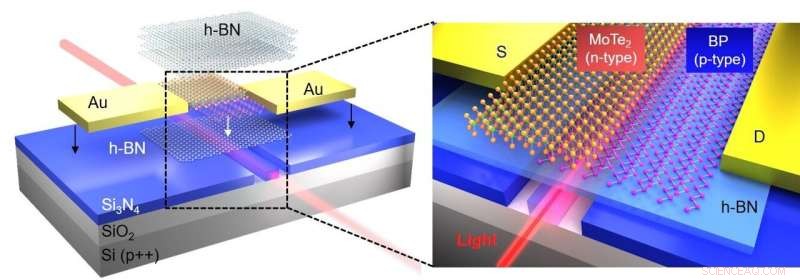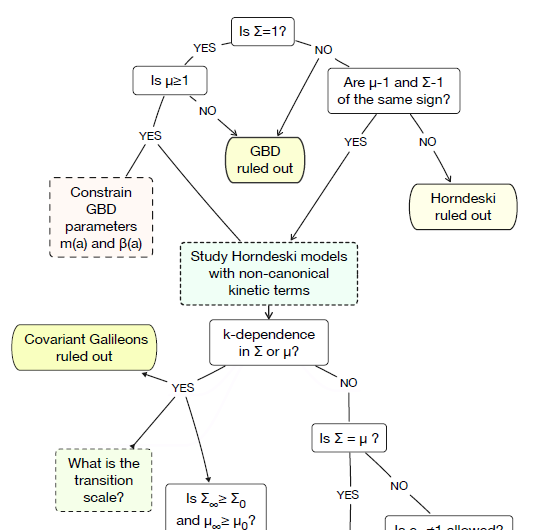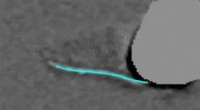Photodetektion på chip:Todimensionelle materiale-heterojunctions

Kredit:Ruijuan Tian, Xuetao Gan, Chen Li, Xiaoqing Chen, Siqi Hu, Linpeng Gu, Dries Van Thourhout, Andres Castellanos-Gomez, Zhipei Sun, Jianlin Zhao
Fotoniske integrerede kredsløb (PIC'er) bruger fotoner som informationsbærere og forventes at løse flaskehalsproblemerne ved mikroelektroniske chips med hensyn til hastighed, strømforbrug og integrationstæthed med deres fordele ved ultrahøj transmissionshastighed, lav forsinkelse og anti-elektromagnetisk krydstale . De er af afgørende betydning for at fremme gennembrud inden for mikroelektronikteknologi, kvanteinformationsteknologi og mikrosensorteknologi i "post-Moore-æraen".
Drevet af anvendelsen af informationsteknologi har fotoniske integrerede chips (PIC'er) gjort store fremskridt. For eksempel er silicium PIC'er kompatible med den modne CMOS-teknologi til lavpris og storskala produktion; Siliciumnitrid PIC'er kunne tolerere moderat høj optisk effekt og store fabrikationsfejl; Lithiumniobat PIC'er kunne opnå perfekte elektro-optiske moduleringer med lav drevet spænding og høj linearitet.
Et af ulemperne ved disse PIC'er er imidlertid den monolitiske integration af bølgeledere og fotodetektorer med et enkelt materiale. For at understøtte lystransmissionen i bølgelederen kan PIC-materialerne ikke absorbere det optiske signal, hvilket gør det umuligt at realisere den integrerede fotodetektor ud af et enkelt materiale. For at løse dette er hetero-integrationer af absorberende bulkmaterialer (såsom Ge, III-V sammensatte halvledere osv.) på PIC'er blevet implementeret. Dette giver dog stadig åbne udfordringer, såsom høje omkostninger, komplicerede fremstillingsprocesser og materialegrænsefladeproblemer.

Båndjustering af BP/MoTe2 PN heterojunction i den termiske ligevægtstilstand (venstre panel); Optisk mikroskopbillede af den fremstillede enhed (højre panel). Kredit:Ruijuan Tian, Xuetao Gan, Chen Li, Xiaoqing Chen, Siqi Hu, Linpeng Gu, Dries Van Thourhout, Andres Castellanos-Gomez, Zhipei Sun, Jianlin Zhao
For nylig er todimensionelle (2D) materialer dukket op som et attraktivt fotonabsorptionsmateriale til chip-integrerede fotodetektorer. 2D-materialer har ingen hængende overfladebindinger, hvilket eliminerer gitter-mismatch-begrænsningerne for at hetero-integrere dem med PIC'er. The family of 2D materials has a rich variety of electronic and optical properties, including semi-metallic graphene, insulating boron nitride, semiconducting transition metal dichalcogenides and black phosphorus. As a consequence, chip-integrated photodetectors operating at various spectral ranges could be constructed by choosing appropriate 2D materials.
In a new paper published in Light:Science &Application , a research group, led by Professor Xuetao Gan from Key Laboratory of Light Field Manipulation and Information Acquisition, Ministry of Industry and Information Technology, and Shaanxi Key Laboratory of Optical Information Technology, School of Physical Science and Technology, Northwestern Polytechnical University, China have reported that integrating van der Waals PN heterojunctions of 2D materials on optical waveguides can provide a promising strategy to realize chip-integrated photodetectors with low dark current, high responsivity, and fast speed.
With the 2D layered structure and no dangling bonds, researchers can stack 2D materials with different properties in different orders by "stacking wood" to form van der Waals heterostructures with atomically flat interfaces. The "arbitrary combination" of van der Waals heterojunctions can not only give the advantages properties of a single material, but also generate novel properties, achieving a leap of 1+1>2. In this research, the researchers made full use of natural p-doped BP and n-doped MoTe2 for hetero-stacking, and successfully fabricated an efficient van der Waals PN heterojunction.
Also, since there are no dangling bonds on the surface of 2D materials, compared with traditional semiconductors, 2D materials do not need to consider lattice mismatch when integrating with various photonic integration platforms. Finally, the preparation of source-drain electrodes can also be integrated on the photonic platform through the "stacking wood" technology and placed on both sides of the material, without cumbersome processes such as photolithography. This also greatly simplifies the fabrication process of the device and reduces the fabrication cost of the device, avoiding the contamination of the device interface by processes such as photolithography, which greatly improves the performance of the device. + Udforsk yderligere
2-D-based single photon emitters integrated with CMOS-compatible silicon nitride waveguides
 Varme artikler
Varme artikler
-
 Nyt rutediagram til eliminering af universmodellerI et rutediagram, Alessandra Silvestri og Levon Pogosian besvarer spørgsmål med ja og nej, fører til den efterfølgende konklusion. For eksempel, hvis μ er større end en og Σ er mindre, så er en stor s
Nyt rutediagram til eliminering af universmodellerI et rutediagram, Alessandra Silvestri og Levon Pogosian besvarer spørgsmål med ja og nej, fører til den efterfølgende konklusion. For eksempel, hvis μ er større end en og Σ er mindre, så er en stor s -
 Kaffemaskine hjælper fysikere med at lave mere effektive ionfælderEksperimentel opsætning til undersøgelse af nye ionfælder. Kredit:ITMO University Forskere fra ITMO University har udviklet og anvendt en ny metode til analyse af det elektromagnetiske felt inde i
Kaffemaskine hjælper fysikere med at lave mere effektive ionfælderEksperimentel opsætning til undersøgelse af nye ionfælder. Kredit:ITMO University Forskere fra ITMO University har udviklet og anvendt en ny metode til analyse af det elektromagnetiske felt inde i -
 Hvilke farver absorberer mere varme?Varmeenergi adlyder de samme bevaringslove som lysenergi. Hvis et bestemt stof reflekterer de fleste lysbølgelængder, reflekteres også den mest varmeenergi. På grund af arten af det visuelle lys har
Hvilke farver absorberer mere varme?Varmeenergi adlyder de samme bevaringslove som lysenergi. Hvis et bestemt stof reflekterer de fleste lysbølgelængder, reflekteres også den mest varmeenergi. På grund af arten af det visuelle lys har -
 Skaber bølger:Forskere kaster lys over, hvordan cilia fungererKropsbevægelsen annulleres, og basis af cilium er fikseret. Den blå linje svarer til den matematiske beskrivelse af ciliumets position. Den røde cirkel svarer til grundlaget for cilium. Videoen sænkes
Skaber bølger:Forskere kaster lys over, hvordan cilia fungererKropsbevægelsen annulleres, og basis af cilium er fikseret. Den blå linje svarer til den matematiske beskrivelse af ciliumets position. Den røde cirkel svarer til grundlaget for cilium. Videoen sænkes
- Sådan ser rullende mørklægninger ud fra rummet
- Forskere bruger husholdningsovne til at hjælpe med at dekontaminere kulstofnanorør
- NASA fanger nydannede Tropical Cyclone 11S
- Ingeniører bruger elektricitet til at rense giftigt vand
- GPM -satellit opnår en fremragende udsigt over Beryls rester
- Liste over afslappende reproducerende organismer


